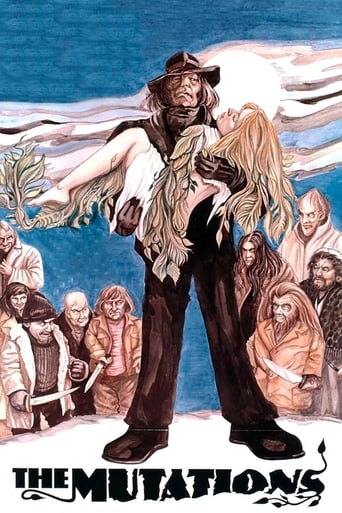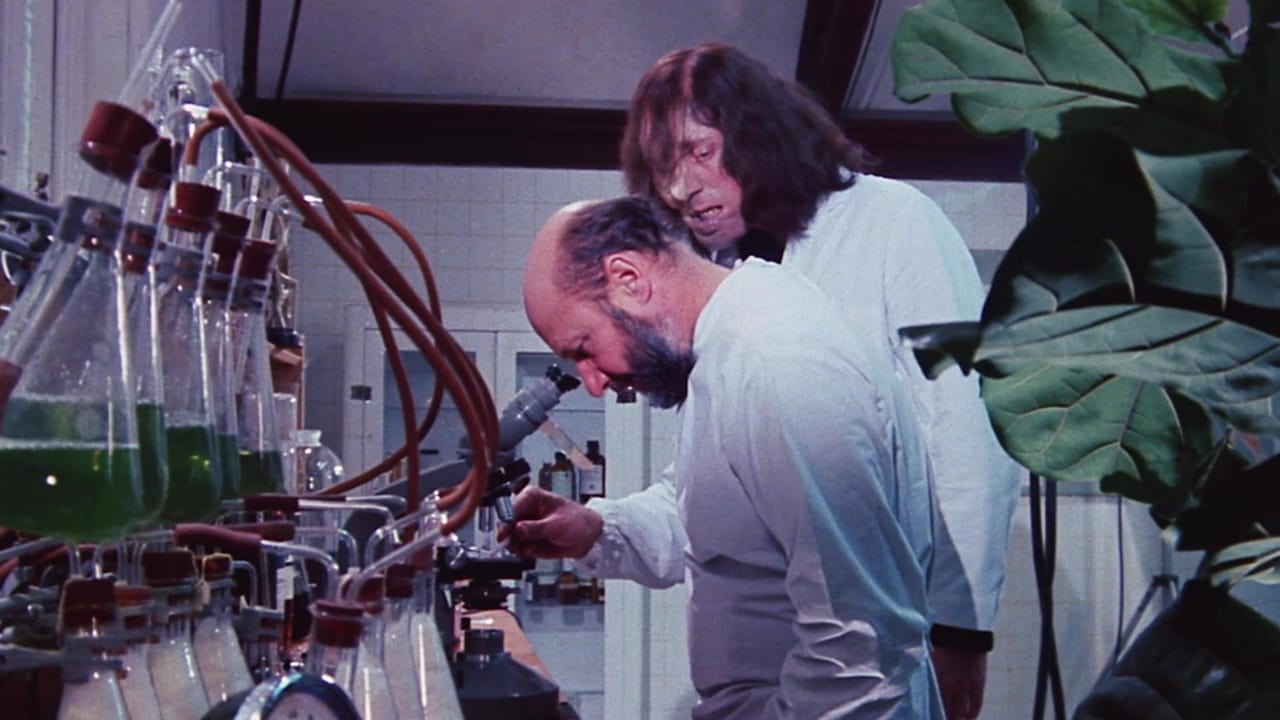Richard Chatten
I thought Freddie Francis had hit rock bottom in his slide from Oscar-winning cameraman to director of schlock horror when he made 'Trog'; but Jack Cardiff fell even further when he was reduced to making this grotesque trash in which he drags down with him a cast with more respectable work behind them, here plainly slumming it (Tom Baker is probably relieved that he was almost unrecognisable in this), yet shot in incongruously saturated colours.At a time when the British cinema was at its absolute nadir, this would have been tasteless enough if it hadn't also had the nerve to frequently evoke Tod Browning's 'Freaks', including scenes in which the late Michael Dunn and the film's genuine 'freaks' are more touching than the film deserves. There are plentiful signs of earlier mad scientist movies plundered, all of which it far surpasses in producing a final monster modelled on the Venus Fly Trap so grotesquely ridiculous-looking the film's makers do their best to make sure we don't see too much of it; but even that is too much.Michael Dunn died over a year before the film was released, and I suspect it had a troubled production. Horror authority David Pirie would have been the man to tell us what the British Board of Film Censors made of it; but it languishes in such merited obscurity it's not even included in the revised edition of his exhaustive study of the British horror film, 'A Heritage of Horror'.
dr_gonzo
Ignore the uptight weirdo who spends 10,000 words bashing this movie. It's very enjoyable as long as you're a fan of the genre. With many gratuitous LSD references and a real live carnival freak show, how can you go wrong? If you thought Swamp Thing was too intellectual and The Fly was just too gross, this movie might definitely be for you. One of many human-cross-animal or plant movies, what causes this one to stand out is the overall creepiness of Donald Pleasance and, basically, the entire plot (what you can make of it).Time-lapse photography inserted for no particular reason just adds to the fun. The people who made this movie must have had a blast and so will you as long as you're not some amateur wannabe film critic. Sheesh!
fertilecelluloid
Grimy, effective English shocker from Jack Cardiff is not a remake of Browning's "Freaks", but it does recreate several sequences from the 30's classic and uses some real, highly impressive freaks (to its credit). The tabletop scene, which introduced the "One of us!" mantra, is here, as is the scene in which the freaks turn on one of their own. One of the little people in this version even produces a threatening switchblade, mirroring the original.Often titled "The Mutations", a title I prefer, the film is entertaining and filled with the great stuff of horror films -- deformities, a mad scientist, a sleazy carnival, half man/half monsters looking for love, a fiery conclusion.The film feels like Gary Sherman's "Raw Meat" at times with its 70's dialog and haircuts, and the female characters wear a little Women's Lib on their shoulders, again reflecting the period. But what really distinguishes the film is director Jack Cardiff's effort to make some of his most hideous freak creations sympathetic. In particular, Tom Baker (TV's best Dr. Who, in my opinion) is gruesomely tragic as Mr. Lynch, a facially disfigured monster who begs mad scientist Professor Nolter (Donald Pleasence) to find a "cure" for his infliction. A scene where Lynch visits a prostitute and begs her to say "I love you" to him (for an extra pound) is quite touching..."I've got a nice selection of obscenities," she tells him when he initially asks her to say "things" to him.The film is a rich tapestry and its theme is summed up in a couple of lines of dialog: "We are all a product of mutations. We mutated to survive." Plot involves Nolter's efforts to forcibly mutate local lasses and lads who end up as monsters running the streets in search of blood. The sideshow of a local carnival provides the perfect hiding place for some of the good Professor's rejected experiments. A particularly chilling scene involves one of the film's protagonists discovering a missing girl in a cage.The make-up effects are more than adequate for their time and disturbingly gruesome. The score by Basil Kirchin, which combines animalistic sound effects with traditional strings, adds immeasurably to the atmosphere. Great time lapse photography of plants, too, cut to ultra-creepy music.I like this accomplished horror film very much.
Tom May
Now what were they thinking...? This film is an outright one-off, granted, but a disastrous one. Little thought seems to have gone in, and when there is thought, it is reflected in a composer's score that transcends and barely fits the images.Let's not contemplate the script at length; word or narrative craftsmen are resoundingly not at work here. Unexplained, irrelevant scenes clutter the film's third-hand B-movie premise. For example, whither the 'dancing instructor'
? Lynch's startling, vulnerable scene with the prostitute is bizarrely isolated, and unfortunately not given emotional context in the rest of this peculiarly ramshackle film. Ethical question-marks starkly rear into view with the use exploitation, rather of real-life freaks in the 'fictitious' side-show. A freak show is effectively shown for five minutes of the film's duration, and it is profoundly unsettling viewing: seedy, dank, sickening; one really wonders what went on behind-the-scenes here
This film was made in 1973; there is no method to this display, beyond the flexing of cheap 'shock tactics'. As Brian says, "I didn't know these shows still existed". Clearly in the seedy world of 1970s low-rent British film, they did.Very little in this film seems other than fake, besides, obviously, the actuality of the 'freaks'' 'abnormalities'. But there is little obvious entertainment value in the mad-scientist straddling, penthouse-peopled 'England' of "The Mutations". This is the worse considering what appears to be an effort at naturalism in the opening, which pins things down in staid, dully scientific terms. Need it be said that Pleasence is an embarrassment here? He is clearly on auto-pilot, giving little effort in what he surely knows is a farrago of a film. How utterly predictable that his dull professor is adorned with a Germanic accent? How stultifyingly insipid to model Nolter's delivery on that of a dry automaton? This spectacularly dull performance oxymoron intended sets the tone, and his oratory barely extends beyond the front rows of the London University lecture theatre. Ever more bizarrely, this lacklustre lecturer and stolid Sice-head is described as 'sexy', in pronouncedly giddy tones, by one of his students. This Lauren is something of an incessant, beaming blonde with fetching pigtails, invested, intentionally or otherwise, with vacuousness by Jill Haworth. What mostly lingers in the mind is her odd relish in watching the freak show, as if it were somehow a heart-warming spectacle.She just about convinces as a student, at least in physical appearance, but she gives no impression that she reads Bio-Chemistry at degree level. Furthermore, Scott Antony's Tony is akin to any old token japer from the world of dispiriting 1970s British films (TM); has he wandered in from a depressingly small-fry juvenile sex comedy? The group of 'students' is rounded out with the Scandinavian curves of Julie Ege - bland and given tokenistic Leary invocations - and a girl who is quickly dispatched by the IDS-dull Pleasence. Oh, and did I forget our dear old Brian? Brad Harris 'essays', or rather phones in, an American 'scholar' who seems more like a redundant detective or sidelined action-hero. He has no real business being there, and yet somehow appears to have picked up Hedi as a girlfriend within a few minutes. This 'Sturdy Oak' archetype single-handedly 'saves the day' at the end, in place of the hapless students; admittedly, Haworth's simpering, would-be 'cool chick' seems unduly discarded, but would have been rendered useless and screaming by the chauvinistic script. One ought to reflect whether she was actually the only real student, as when Tony asks for entry to see the 'Lizard Woman' act, he specifically asks for "three and a half tickets" when four are there... Such pointless but amusing asides aside, Tom Baker is passable as a deformed ruffian and lunatic called Lynch. Hopefully no child fan of "Dr Who" ever stumbled upon this film, hearing of his presence: they'd be scarred for life! He overacts extravagantly in the "He's One of Us!" scene, which puts Tod Browning's similar scene in "Freaks" through the wringer; the freaks are played for all their 'weirdness' and treated as sinister; see also the inexplicable, brutish and farcical fog-drenched demise of Lynch, and indeed two of them stalking and capturing Olga Anthony's willowy unfortunate.Other than for reasons of historical or academic study, I'd advise people not to see this appalling spectacle. However, there is a sole, sublime saving grace: the musical soundtrack. This majestic and incredibly innovative free-jazz music is on an altogether different plane to the squalid, murky seediness of the images. It is almost as if the soundtrack was a record that has been superimposed over the film and it should be noted that Basil Kirchin drew some of its themes from his ongoing "Worlds Within Worlds" series. Merely the time-lapse Open University-esquire opening photography tallies with the alternately sedate and barnstorming strains of Kirchin's music. There are high pitched string-instrument stings redolent of plant life, that periodically score 'tension', but generally, the score is of another world, and utterly un-telegraphed. It should be released on CD in full; while this film is forgotten, this music should live in its own context, in its interpolating sedate deathliness and cacophonous blaring.The opening to the film indeed is mercifully sedate and horn-rimmed-spectacled, in comparison to the ghastliness to come. Eastmancolour skies and dappled, felt-like plants, seem of another age, backed by the awe-inducing music. But... well, things ebb, completely
in all manner of exploitative, numb-skulled directions. To think that the lens-man of "The Red Shoes", Jack Cardiff, actually directs this... For me, the distasteful idiocy of this 'contemporary' 1973 film is ultimately exemplified by the smug, complacent face of Scott Antony; when the Monkey Woman enters, he tastelessly jokes "all sounds pretty hairy to me!" and in reply Jill Haworth's kittenish features crease into a fawning laughter. The only balm is the music.


 AD
AD





